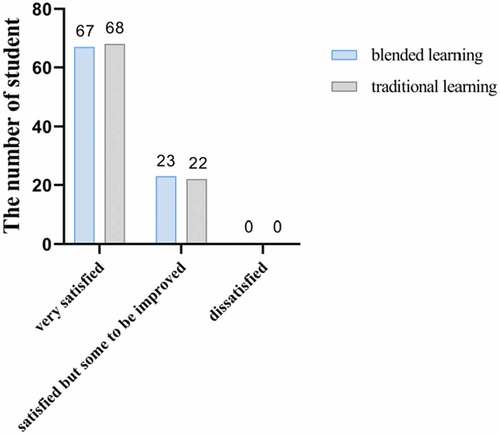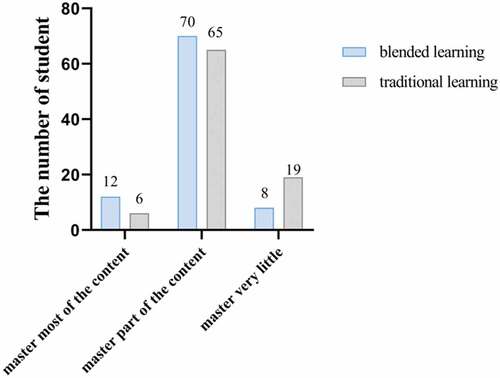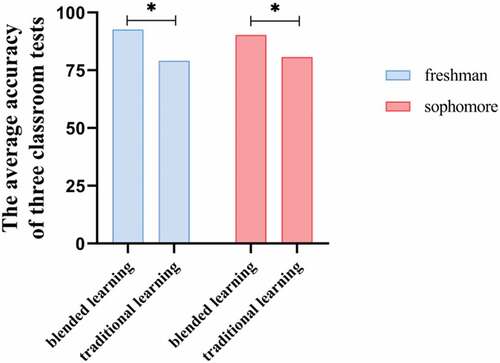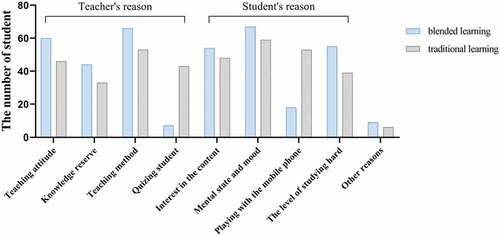Abstract
In recent years, online learning has been widely used than before. However, it depends on student’s learning initiative and lacks of teacher-student interaction, which cannot bring desired learning performance. In our physiology teaching practice to “5 + 3” integration medical student, we tried to combine online and classroom learning to form the blended learning. This study assessed the effectiveness of the blended learning on students’ learning initiative and performance in the physiology study. It included 180 full-time students from clinical medical specialty across two academic years. These students were divided into the experimental classes receiving blended learning and the control classes receiving traditional learning. We carried out three classroom tests and one questionnaire survey. It found that the students of blended learning who mastered most of the content were as twice as the students of traditional learning. The average accuracy of classroom tests was above 90% from the students of the blended learning, which was higher than the approximate rate of 80% of from the students of the traditional learning. Both the times of preparing lessons and answering questions in class increased in the blended learning practice. In addition, students of blended learning were relatively unaffected by playing with the mobile phones in the class. It found that students acquired more knowledge, performed better in the classroom tests and their learning initiative was excited in the blended learning.This study provides the effect assessment and contributes to improve the teaching effect of the blended learning.
PUBLIC INTEREST STATEMENT
Blended learning is a new teaching and learning strategy in recent years. It combines face-to-face learning with online learning. This study examined the effectiveness of the blended learning on students’ learning initiative and performance in the physiology study. The findings indicated that students acquired more knowledge, performed better in the classroom tests and their learning initiative was excited in the blended learning. It seems that the blended learning is more attractive than traditional teaching. In addition, some shortcomings of blended learning are revealed from the questionnaire survey. The skills of instructors such as assigning task, organizing discussion and summarizing should be improved in the blended learning approach. It encourages the instructors to improve their teaching abilities and change their old teaching methods in future blended learning of physiology.
1. Introduction
Traditional classroom learning has always been a leading mode adopted by instructors in the college. Since the outbreak of pneumonia caused by COVID-19 in 2020, online learning has satisfied most of the students at home because of the closure of school (Qing Jin et al., Citation2021). And undoubtedly, online learning becomes increasingly to be recognized and more than the supplement of classroom learning. Compared with traditional learning, online learning is more flexible, less restriction but requiring student’s learning initiative (de Leeuw et al., Citation2019; O’doherty et al., Citation2018; Tang et al., Citation2018). Bandura considers that we learn through observing, modeling and communicating with others. In his social-cognitive model, both the subjective influences that learners bring to a learning situation and the influence of emotion determine learning effect (Rasouli & Hamdi, Citation2020; Robinson, Citation2013). When students learn from online learning platform, low levels of engagement and negative emotions such as frustration and isolation that lead to less effective learning (Robinson, Citation2013). To remove these disadvantages, a blended learning design where some course elements are conducted in a traditional classroom setting while other course elements are delivered online was adopted by us. The blended learning combined face-to-face instruction with online instruction (Enoch et al., Citation2022; Fehl et al., Citation2022; Majeed & Dar, Citation2022; Matosas-López & Cuevas-Molano, Citation2022). In order to enhance learning effect, we adopted the blended learning to give lessons to the “5 + 3” integration medical students (Five years of undergraduate plus three years of graduate study) in the teaching practice. Those freshmen and sophomores from clinical medical specialty had obtained the highest scores in the entrance examination in our college. They were intelligent enough but many students lack engagement in the class, which caused poor performance in the physiology study. Student engagement within a lesson mainly includes three aspects: emotional, behavioral and cognitive engagement. Emotional engagement is recognized as students’ affective reactions to classroom activities, behavioral engagement is observable behaviors directly related to the learning process, and cognitive engagement is students’ cognition about the importance of their education (Robinson, Citation2013). Students whom are highly engaged will study hard and acquire more knowledge. They prefer to participate in the learning and perform better in the class (André Viljoen et al., Citation2020; Ansar et al., Citation2021; Cadet, Citation2021; Wu et al., Citation2020; Zheng, Citation2021). How can teachers improve their teaching so as to motivate students with high levels of engagement? Here, we design a blended learning approach that includes setting the preview questions, watching videos, lecture, discussion, knowledge expansion, summarization and tests. The variety of blended learning probably fosters the engagement of students.
2. Literature review and instructional design
2.1. Literature review
There have been studies on the blended learning in recent years. Some scholars believe that the blended learning has positive effects that improve the theoretical marks (Balakrishnan et al., Citation2021; Bock et al., Citation2021; Cao et al., Citation2021; Ma et al., Citation2021; Ravat et al., Citation2021). However, some educators declare that there are no obvious advantages of the blended learning from their teaching practice (Bamoallem & Altarteer, Citation2022; Nazar et al., Citation2019; Venkatesh et al., Citation2020). A survey done by Qian Liu et al. selected 56 eligible published articles from different databases to analyze the effectiveness of the blended learning compared with traditional learning. Their conclusion was that blended learning appeared to have a positive effect, and to be more effective than or at least as effective as for knowledge acquisition in health professions in comparison with traditional learning. But due to the large heterogeneity, that conclusion should be treated with caution (Liu et al., Citation2016). It is necessary to carry out elaborate designs and more investigation to assess the blended learning.
2.2. Instructional design
Physiology is a fundamental course that tells about all kinds of functions and mechanisms of the human body (Widmaier et al., Citation2016). In this study, we gave three lessons of respiratory physiology to sophomores, and gave three lessons including internal environment and homeostasis, cellular electrical activity, energy metabolism and body temperature to freshmen. These students were divided into the experimental classes receiving blended learning and the control classes receiving traditional learning. Besides the classroom tests, the student satisfaction, knowledge acquisition, learning initiative, and factors which influence teaching and learning effects were also evaluated.
3. Methods
3.1. Students
In this study, it included 180 full-time “5 + 3” integration medical students across two academic years, 100 freshmen in class 2020 and 80 sophomores in class 2019 at Harbin Medical University. Some basic information of these students was shown in the Table . Two kinds of instructional approaches included blended learning (50 freshmen and 40 sophomores) and traditional learning (50 freshmen and 40 sophomores). All students had agreed and provided informed consent at the beginning of the study.
Table 1. Basic information of the students investigated in two academic years
3.2. Research design
Before the study, we had told the students there would be two learning approaches and obtained their consent. A blended learning approach had six parts: 1) Set the preview questions. 2) Prepare the lessons in our online learning platform (http://www.xueyinonline.com/detail/216679678). 3) Discuss with students. 4) Teach in the class. 5) Test the students. 6) Summarize the knowledge. A traditional learning approach had three parts: 1) Teach in the class. 2) Test the students. 3) Summarize the knowledge. In addition, the online learning materials such as teaching videos were available to all students, and the time spent in watching teaching videos was also a part of grade of everyone.
3.3. Classroom tests
Three tests were given to the freshmen and sophomores respectively. Three to four single choice questions that covered key points of the lesson appeared in each test. The software Superstar Xuexitong was used to issue questions and calculate the scores automatically for the students of the blended learning, whereas the paper tests that needed marking by the instructor with the same questions were given to the students of the traditional learning.
3.4. Questions in the questionnaire survey
Did you feel satisfied with the physiology course?
How much knowledge did you acquire from our teaching?
How many times did you spend on preparing lessons?
How much time did you spend on listening each lesson in classroom?
Did you watch teacher’s PPT for review after class?
Did you do exercise books for review after class?
Which factors can influence the teaching and learning effects?
3.5. Statistics
Chi-square test was used in comparing the student numbers of blended learning and traditional learning. The scores of classroom tests were analyzed by paired t test. P<0.05 was recognized to be significant. Using Cohen’s d to compare the mean test score’s effect size (Small: 0.2≤d<0.5,Medium: 0.5≤d<0.8,Large: d ≥ 0.8). The validity and reliability of the questionnaire were analyzed by SPSS. Cronbach α is 0.776, and KMO is 0.704.
4. Results
4.1. Student satisfaction was similar in the blended and traditional learning
In this study, the student satisfaction was compared between the blended and traditional learning approaches. The satisfaction degree was subdivided into three levels, as shown in the Figure . The 74% of students were very satisfied with blended learning, and the similar satisfaction rate of 76% was received from the traditional learning students. Another 26% of the blended learning students and 24% of the traditional teaching students were satisfied with our physiology lessons but gave some suggestions. None of the students was dissatisfied. It demonstrated that students can accept both two instructional approaches without obvious difference.
4.2. Students of the blended learning acquired more knowledge
It was important to know how much of knowledge the students acquired from the physiology lessons. Through the questionnaire survey, it found that the students of the blended learning who mastered most of the content were as twice as the students of the traditional learning, but the students of the blended learning who learned about very little knowledge were less than a half of the students of the traditional learning (Figure ). The comparisons between the two groups were statistically different (P = 0.0357). The blended learning appeared to have a positive effect for knowledge acquisition on physiology in comparison with traditional learning.
4.3. Students of the blended learning performed better in the classroom tests
To evaluate the teaching and learning effects, we issued a classroom test in each lesson and collected the data to calculate the accuracy of each test (Figure ). The average accuracy was 92.65% from the freshmen of the blended learning, which was higher than the rate of 79.16% from the freshmen of the traditional learning (P = 0.0251, Cohen’s d = 3.47, Effect Size = 0.86). And the similar rate of 90.30% from sophomores of blended learning was in comparison with the rate of 80.72% from sophomores of traditional learning (P = 0.0486, Cohen’s d = 3.06, Effect Size = 0.83). Using Cohen’s d to compare the effect sizes, the result belonged to a large effect. These results demonstrated that the students of blended learning from two academic years performed better in the classroom tests than those of traditional learning students.
4.4. Student’s learning initiative was excited in the blended learning practice
To know about what made students to acquire more knowledge in the blended learning practice, we focused on the learning initiative and studied some components contributing to learning initiative. First, the times of preparing lessons were obviously more than those of students in traditional learning (P<0.0001, Figure ). One primary reason was that the teacher asked for the students to prepare lessons in the online learning platform ahead of the lessons. Another important reason was that pre-class preparation can help the students to participate in the discussion in the class. Because of pre-class preparation in the blended learning, the students preferred to answer and raise questions (P = 0.0003, Figure ), which expanded and strengthened their knowledge. For the review part, we compared the number of students who watched teacher’s PPT and did exercise books after class. Most of the students reviewed the lessons with the help of teacher’s PPT and exercise books, and the statistical differences were not significant between two groups (P = 0.2127 and P = 0.5077, Figure ). In summary, both the times of preparing lessons and answering questions in class increased in the blended learning practice, which suggested that the blended learning excited student’s learning initiative.
Figure 4. Comparison of student’s learning initiative between two learning approaches.
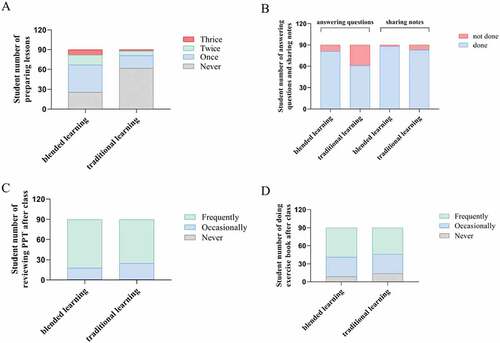
4.5. The analysis of factors that influenced on the student’s learning effect
To find out which factors mainly influenced teaching and learning effects, we carried out the questionnaire survey. These factors were divided into the teacher’s reasons and student’s reasons (Figure ). More students in the blended learning practice thought teaching attitude, knowledge reserve, teaching method, interest in the content, mental state and mood, the level of studying hard as significant factors to determine student’s learning effect. However, besides the above factors, more students in the traditional learning practice considered examining student and playing with the mobile phone as key factors. These results indicated that students of blended learning were relatively unaffected by playing with the mobile phones in the class but they needed finely trained teaching skills of instructors.
5. Discussion
5.1. Discussion
Learning physiology well is very important to clinical medical students. Knowing the normal functions and mechanisms of human body well is the basis for studying pathology, pathophysiology, pharmacology and multiple clinical courses. In most of medical colleges of China, physiology is a compulsory course that is studied hard by the students. Here, we tried to combine the online learning and classroom learning to form the blended learning in order to excite student’s learning initiative and improve performance. A blended learning approach included six parts: set the preview questions, prepare the lessons in our online learning platform, discuss with students, teach in the class, test the students and summarize the knowledge. In the first two parts, we noticed the students three preview questions in the WeChat group a day ahead of time. The students watched two or three teaching videos independently each time and found the answers from them in online learning platform. This mode encouraged our students to learn with the questions and we found that the times of preparing lessons of these blended learning students were obviously more than those of students in traditional learning, although the online learning materials such as teaching videos were available to all students. In the second two parts, the instructor taught the contents and organized the students to attend the discussion according to the previous preview questions. On account of preparing the lessons well, these blended learning students preferred to answer and raise questions in the class and can acquire more expanded knowledge given by the instructor. However, the extended knowledge was shared with students of traditional learning as a file that was probably left in the bag after class. In the last two parts, the instructor used the software Superstar Xuexitong to issue questions and summarize timely, and the students answered them in this software. Once done, both the students and instructor can see who selected right answers and who selected wrong in the software, which urged the students to answer the questions carefully. This saved class time and made the students to become more aware of their own shortcomings and encouraged them to communicate with others. But traditional paper tests did not be graded and made statistics timely, which caused low effectiveness.
How did the blended learning approach help students to gain more knowledge compared with the traditional learning? First, students watched the teaching videos ahead of the lessons and spent more time in preparing the lessons. They found the answers in the video and hence gained some of the knowledge ahead of the lessons. Secondly, in order to discuss with others better, some of the students spent time going through all related reference material and gained the knowledge outside the textbook. Thirdly, because the students prepared lessons before class, there was more time in expanding knowledge in the class. By analyzing the accuracy of the classroom tests, we found that the students of blended learning from two academic years performed better than those of traditional learning students. Using Cohen’s guidelines for describing effect sizes, the result belonged to a large effect (Ponce-Renova, Citation2022).
5.2. Practical implications
Moreover, it is also necessary to know how students feel the blended learning course and their feedback on its effectiveness. We carried out the questionnaire survey to find out what factors influenced teaching and learning effects. The main factors which affected students’ learning were same, such as the same textbook, class time, tests and assignments, but some specific factors were different. More students in the blended learning practice thought that teaching attitude, knowledge reserve and teaching method are three important teacher’s reasons which influence the blended teaching effects. It encourages the instructors to improve their teaching abilities and change their old teaching methods to teach the students better. Furtherly, more students of blended learning thought the interest in the content, mental state and mood, the level of studying hard as student’s reasons to determine learning effects rather than playing with the mobile phone. This feedback was particularly important because it reflected a phenomenon, that was, students of the blended learning had been permitted to use mobile phones in the class but they did not play, while more students of traditional teaching were doing things unrelated to learning in the class. It seems that the blended learning is more attractive than traditional teaching. Researchers and educators should pay more attention to the skills of instructors such as assigning task, organizing discussion and summarizing in the blended learning approach. Blended learning could be promising and worthwhile for further application in physiology teaching. The results impel us to arrange more teaching activities to draw attention to the students in the class. In this study, we evaluated the effectiveness of blended learning compared with traditional learning. In the future teaching practice, we will continue to improve the teaching quality of the blended learning in physiology.
6. Conclusion
It found that students acquired more knowledge, performed better in the classroom tests and their learning initiative was excited in the blended learning. This study indicated that students of blended learning were relatively unaffected by playing with the mobile phones in the class but they needed finely trained teaching skills of instructors.
Informed consent
Before the study, we had told the students there would be two learning approaches and obtained their consent.
Disclosure statement
No potential conflict of interest was reported by the authors.
Additional information
Funding
Notes on contributors

Xiaolan Zhang
Xiaolan Zhang is an associate professor in the Department of Physiology, Harbin Medical University, China. She won the second prize in the micro-course teaching competition of Chinese Physiology Society (2019). The author’s team mainly focuses on teaching, formative assessment, educational innovation and ability training in Physiology. Since the epidemic in 2020, the team has gained extensive experience in the blended learning. Combined with actual problems encountered and constantly improved instructional design, she and her colleagues have achieved good teaching results during online and offline teaching practice. This study is part of a larger project that aims to develop blended learning in China.
References
- André Viljoen, C. A., Scott Millar, R. S., Manning, K., & Celeste Burch, V. C. (2020). Effectiveness of blended learning versus lectures alone on ECG analysis and interpretation by medical students. BMC Medical Education, 20(1), 488. https://doi.org/10.1186/s12909-020-02403-y
- Ansar, A., Rafi, A., & Rizvi, R. M. (2021). Is behaviourism really dead? A scoping review to document the presence of behaviourism in current medical education. The Journal of the Pakistan Medical Association, 71(4), 1214–10. https://doi.org/10.47391/JPMA.830
- Balakrishnan, A., Puthean, S., Satheesh, G., Unnikrishnan, M. K., Rashid, M., Nair, S., & Thunga, G. (2021). Effectiveness of blended learning in pharmacy education: A systematic review and meta-analysis. Plos One, 16(6), e0252461. https://doi.org/10.1371/journal.pone.0252461
- Bamoallem, B., & Altarteer, S. (2022). Remote emergency learning during COVID-19 and its impact on university students perception of blended learning in KSA. Education and Information Technologies, 27(1), 1–23. https://doi.org/10.1007/s10639-021-10660-7
- Bock, A., Kniha, K., Goloborodko, E., Lemos, M., Barbara Rittich, A. B., Christian Möhlhenrich, S. C., Rafai, N., Hölzle, F., & Modabber, A. (2021). Effectiveness of face-to-face, blended and e-learning in teaching the application of local anaesthesia: A randomised study. BMC Medical Education, 21(1), 137. https://doi.org/10.1186/s12909-021-02569-z
- Cadet, M. J. (2021). Examining the Learning Characteristics of Nursing Students: A Literature Review. The Journal of Nursing Education, 60(4), 209–215. https://doi.org/10.3928/01484834-20210322-05
- Cao, W., Hu, L., Li, X., Xiaoling, X., Chen, C., Zhang, Q., & Cao, S. (2021). Massive Open Online Courses-based blended versus face-to-face classroom teaching methods for fundamental nursing course. Medicine (Baltimore), 100(9), e24829. https://doi.org/10.1097/MD.0000000000024829
- de Leeuw, R., de Soet, A., van der Horst, S., Walsh, K., Westerman, M., & Scheele, F. (2019). How we evaluate postgraduate medical e-learning: Systematic review. JMIR Medicine Education, 5(1), e13128. https://doi.org/10.2196/13128
- Enoch, L. C., Abraham, R. M., & Singaram, V. S. (2022). A comparative analysis of the impact of online, blended, and face-to-face learning on medical students’ clinical competency in the affective, cognitive, and psychomotor domains. BMC Medical Education, 22(1), 753. https://doi.org/10.1186/s12909-022-03777-x
- Fehl, M., Gehres, V., Geier, A.K., Mundt, T., Klinge, K., Frese, T., Bleckwenn, M., & Deutsch, T. (2022). Medical students’ adoption and evaluation of a completely digital general practice clerkship – cross-sectional survey and cohort comparison with face-to-face teaching. Medical Education Online, 27(1), 2028334. https://doi.org/10.1080/10872981.2022.2028334
- Liu, Q., Peng, W., Zhang, F., Hu, R., Li, Y., & Yan, W. (2016). The Effectiveness of Blended Learning in Health Professions: Systematic Review and Meta-Analysis. Journal of Medical Internet Research, 18(1), e2. https://doi.org/10.2196/jmir.4807
- Ma, X., Ma, X., Ling, L., Luo, X., Zhang, H., & Liu, Y. (2021). Effect of blended learning with BOPPPS model on Chinese student outcomes and perceptions in an introduction course of health services management. Advances in Physiology Education, 45(2), 409–417. https://doi.org/10.1152/advan.00180.2020
- Majeed, M., & Dar, F. R. (2022). Investigating the efficacy of blended learning in ESL classrooms. Cogent Education, 9(1), 2133500. https://doi.org/10.1080/2331186X.2022.2133500
- Matosas-López, L., & Cuevas-Molano, E. (2022). Assessing Teaching Effectiveness in Blended Learning Methodologies: Validity and Reliability of an Instrument with Behavioral Anchored Rating Scales. Behavioral Sciences, 12(10), 394. https://doi.org/10.3390/bs12100394
- Nazar, H., Omer, U., Nazar, Z., & Husband, A. (2019). A study to investigate the impact of a blended learning teaching approach to teach pharmacy law. The International Journal of Pharmacy Practice, 27(3), 303–310. https://doi.org/10.1111/ijpp.12503
- O’doherty, D., Dromey, M., Lougheed, J., Hannigan, A., Last, J., & McGrath, D. (2018). Barriers and solutions to online learning in medical education – an integrative review. BMC Medical Education, 18(1), 130. https://doi.org/10.1186/s12909-018-1240-0
- Ponce-Renova, H. F. (2022). Comparing effect sizes and their confidence intervals: A primer on equivalence testing in educational research. Journal of New Approaches in Educational Research, 11(2), 209–225. https://doi.org/10.7821/naer.2022.7.930
- Qing Jin, Y., Lin, C.L., Zhao, Q., Sung-Wen, Y., & Yu-Sheng, S. (2021). A study on traditional teaching method transferring to E-Learning under the covid-19 pandemic: from Chinese students. Frontiers in Psychology, 12, 632787. https://doi.org/10.3389/fpsyg.2021.632787
- Rasouli, G., & Hamdi, K. (2020). Helping relief campaigns: Social cognitive factors underlying important issues using structural equation modelling. Cogent Business & Management, 7(1), 1823596. https://doi.org/10.1080/23311975.2020.1823596
- Ravat, S., Barnard-Ashton, P., & Keller, M. M. (2021). Blended teaching versus traditional teaching for undergraduate physiotherapy students at the University of the Witwatersrand. South African Journal of Physiotherapy, 77(1), 1544. https://doi.org/10.4102/sajp.v77i1.1544
- Robinson, K. (2013). The interrelationship of emotion and cognition when students undertake collaborative group work online: An interdisciplinary approach. Computers & Education, 62, 298–307. https://doi.org/10.1016/j.compedu.2012.11.003
- Tang, B., Coret, A., Qureshi, A., Barron, H., Ayala, A. P., & Law, M. (2018). Online lectures in undergraduate medical education: Scoping review. JMIR Medicine Education, 4(1), e11. https://doi.org/10.2196/mededu.9091
- Venkatesh, S., Rao, Y. K., Nagaraja, H., Woolley, T., Alele, F. O., & Malau-Aduli, B. S. (2020). Factors Influencing Medical Students’ Experiences and Satisfaction with Blended Integrated E-Learning. Medical Principles and Practice, 29(4), 396–402. https://doi.org/10.1159/000505210
- Widmaier, E. P., Raff, H., & Strang, K. T. (2016). Human physiology: The mechanisms of body function (Fourteenth ed.). McGraw-Hill Education.
- Wu, H., Li, S., Zheng, J., & Guo, J. (2020). Medical students’ motivation and academic performance: The mediating roles of self-efficacy and learning engagement. Medical Education Online, 25(1), 1742964. https://doi.org/10.1080/10872981.2020.1742964
- Zheng, J. (2021). A Functional Review of Research on Clarity, Immediacy, and Credibility of Teachers and Their Impacts on Motivation and Engagement of Students. Frontiers in Psychology, 12, 712419. https://doi.org/10.3389/fpsyg.2021.712419

